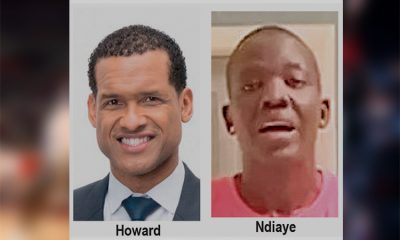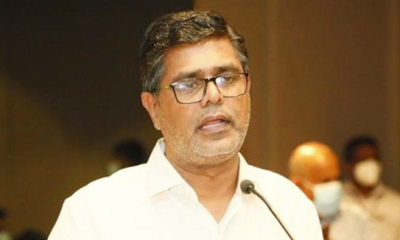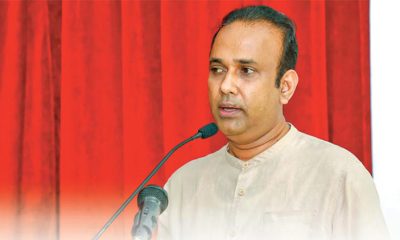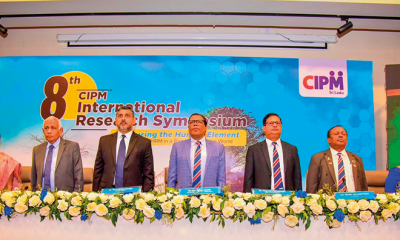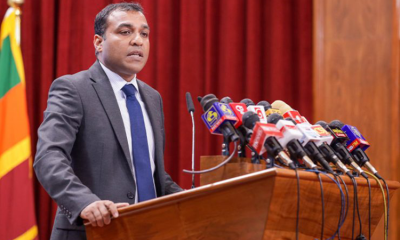Features
Noble kinght, leader of the brave array
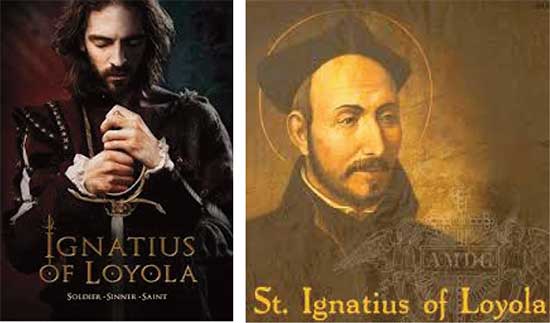
By Fr. Prabath Sanjeeva
Fernando, S.J. LEGEND IS BORN
Iñigo Lopez de Oñaz y Loyola, whom we know as St. Ignatius of Loyola, was the founder Father of the Society of Jesus, (in fact St. Ignatius preferred being called as the co-founder). Iñigo Lopez de Loyola, was chasing after military fame and fortune when a cannon ball arriving like a thunderbolt, shattered his leg and crushed his hope-filled dreams. The cannon ball not only broke his leg, but also his image as a handsome, dashing courtier, the vainglory that he had lived for; was shattered, too. It is aptly said, that sometimes, God lets you hit rock bottom, so that you will discover Him as the Rock, at the bottom. Since the bone was protruding after the operation, it exhibited an awkward appearance as he walked. He could not tolerate such a black marked stain on the spotless veneer of his esteem. Thus, Iñigo insisted on having the leg re-broken and re-set; even without anesthetic. At times, isn’t it true, that in life, no matter how hard we try to fix certain idiosyncrasies imposing our own will, they would nevertheless remain the same or get even worse! The similar fate occurred in the life of our saint. In the end, one leg was still shorter than the other. Therefore, Iñigo had to limp for the rest of his life.
During the time of his convalescence, Ignatius loved to read romantic novels and daydream of a princess who would be his own. However, the next chapter of life had its own U-turn. In the rest home, the only available books were the Life of Christ and the Lives of the Saints. Bored and tired, he resorted to these tomes for an adventurous escape. Providentially, these books in turn offered Ignatius a new set of eyes and a unique perspective in following the Prince of Peace, Jesus and the Queen of the Church, the Blessed Virgin Mary. This paradigmatic shift, certainly, I would say, brought this boisterous young man closer to Mary and God. It made a lasting and an indelible impression in his life, so much so that Ignatius made a pilgrimage to the shrine of Blessed Mother Mary, at Montserrat near Barcelona. He remained almost a year at nearby Manresa, in a pauper’s hospice, often in a dingy cave in the hills, praying. After a period of great peace of mind, he went through a harrowing trial of scruples, prayer, fasting, sacraments and penance. In fact, this going through paved a way to a growing through experience in the Lord; And so was born a legend.
Ignatius preferred to be called the ‘Pilgrim’. At La-Storta, a little town outside of Rome, when the pilgrim and the companions stopped to pray at a small chapel, he had a vision of Jesus carrying the cross with the Father at his side. Jesus said to Ignatius, “I wish you to serve us.” Then, the Father added, “I will be propitious to you in Rome”. When in Rome, the Society of Jesus was approved by Pope Paul III in 1540 and thus became an official Catholic religious order. Following this, Ignatius was then elected their first leader (General) wherein he vehemently declined the election for he did not want to fall into the same temptation of the vanity of vanities. Yet, later on, as the rest of the companions insisted, Ignatius agreed upon serving God as the General of the newly-founded Society of Jesus. The apparent distinction was, in contrast to the ambitions of his early days, the fundamental option of the newly-born Ignatius was that we must desire and choose only that which fulfills the end for which we are created – that is to praise, reverence, and serve God through serving other human beings. Ignatius was exceedingly driven by the ardent desire to do everything for the ‘Greater Glory of God’. So much so he prayed:
“Teach us, good Lord, to serve you as you deserve;
to give, and not to count the cost,
to fight, and not to heed the wounds,
to toil, and not to seek for rest,
to labor, and not to ask for reward,
except that of knowing that we are doing your will”.
 Ignatius was a soldier-sinner who turned out to be a mystic-saint. He was a broken legged soldier who in recognizing his sinful past allowed God to mould him to become a contemplative in action. A sickbed conversion changed his entire life, but not without an uphill journey. Perseverance in prayer and total trust in God pulled St. Ignatius out of the darkness that was trying to consume him. There are so many things that could be said of St. Ignatius’ life, especially of how he allowed God to show him who he could become, which was much more than what he thought he could ever be. Ignatius experienced wholly the true meaning of “unconditional” in the commonly known phrase – “God’s Unconditional Love.” Once liberated, he continued to seek out ways and means so that he could share this profound gift and experience, one that I feel is very much needed in our world of today.
Ignatius was a soldier-sinner who turned out to be a mystic-saint. He was a broken legged soldier who in recognizing his sinful past allowed God to mould him to become a contemplative in action. A sickbed conversion changed his entire life, but not without an uphill journey. Perseverance in prayer and total trust in God pulled St. Ignatius out of the darkness that was trying to consume him. There are so many things that could be said of St. Ignatius’ life, especially of how he allowed God to show him who he could become, which was much more than what he thought he could ever be. Ignatius experienced wholly the true meaning of “unconditional” in the commonly known phrase – “God’s Unconditional Love.” Once liberated, he continued to seek out ways and means so that he could share this profound gift and experience, one that I feel is very much needed in our world of today.
LEGACY, ON-GOING
The pilgrim saintly character of St. Ignatius provokes us to commence the journey of faith, by trying to become saints while we are still alive. Understandably, it is a gift that is given, but on the other hand, it also has to be asked and strived for. This journey is quite arduous, for it requires, our radical following of Christ. The clarion call is to live lives of authenticity, purpose driven, and rooted in faith. The saintly life of Ignatius challenges us not to be just the followers but rather to become the leaders, the founders. Hence, we are becoming founders of our true self, our real humanity and becoming who we are created to be every day, by our actions and words. It has been said, don’t follow if your following makes you timid, complacent and average. Therefore, legacy is something daring, life-changing and long-lasting. It goes on and on. It continues to urge us to imbibe the very dynamism that navigated the founder himself. When we tap that source, the river of life begins to flow into our lives and palpably that spirit of the founder is freely available, even today. That power source is active and alive right where we are, waiting to make us enspirited bodies and embodied Spirits.
Ignatius’ strength is derived from the in-depth and personal experience of Jesus and he in turn offers us the Spiritual Exercises to make that inward journey to Jesus the Master and be His apprentice. We need to let our hearts to be pierced and broken so that genuine conversion can be realized. We need to break free of our comfy shells so that the aura of transformation envelops us. Our legs may not be shattered by a cannon but we can certainly become wounded-healers; broken-healers, today.
The followers who become the founders today, would have the fire of His Unconditional Love to go set the world aflame. It is aptly said that ‘if you want to be useful to others, reform the world and renew the society, begin by taking pains with yourself. The fire that is to enkindle others, should be lighted at home first’. We need to conquer ourselves in our sincere attempts to help souls to attain the end for which they are created. ‘Every saint has a sinful past and every sinner has a saintly future’; This statement apparently being credited to Oscar Wilde can only be actualized, if now in the present, we have the wisdom to know the difference. Such a difference can only be understood if one is truly mindful and loving.
At present, the one towering personality that heeded the call and rose to the occasion is the Holy Father, Pope Francis. The founder of the renewal of the Church, who evidently is charged with the grandeur, the fire of God’s love. It is unmistakable in his life style, homilies and of the motto. ‘God, seen through the eyes of Mercy, has chosen me. Pope Francis has been tremendously creative in his approach and yet, he has been extremely faithful to the life-line of the Church’s teachings. We can all adopt this notion of creative-fidelity as a viable support in our lives. We all need that spiritual power generator more than ever. We need the compassionate gaze of the Lord, which shatters our stony-hearts and makes us leaders of the brave array, the founding members of His Reign here on earth. The founders with broken, perhaps shattered yet brave hearts. Thus, to be founders, leaders and saints is not restricted or constrained yet it is freely available and accessible to anyone who wishes to take a stand and be a way-maker and path-finder. We are always invited to let another legend to be born in our own-selves and to continue the legacy of the noble knight. Possibly, the following lines uttered by Pope Francis would give us a clue. “To be saints is not a privilege for the few but a vocation for everyone”.
A blessed Feast of St. Ignatius of Loyola!
(The writer is the ‘National Director’ for Pope’s World-wide Prayer Network & Eucharistic Youth Movement in Sri Lanka. He can be contacted: sanjsj@gmail.com)
Features
The heart-friendly health minister

by Dr Gotabhya Ranasinghe
Senior Consultant Cardiologist
National Hospital Sri Lanka
When we sought a meeting with Hon Dr. Ramesh Pathirana, Minister of Health, he graciously cleared his busy schedule to accommodate us. Renowned for his attentive listening and deep understanding, Minister Pathirana is dedicated to advancing the health sector. His openness and transparency exemplify the qualities of an exemplary politician and minister.
Dr. Palitha Mahipala, the current Health Secretary, demonstrates both commendable enthusiasm and unwavering support. This combination of attributes makes him a highly compatible colleague for the esteemed Minister of Health.
Our discussion centered on a project that has been in the works for the past 30 years, one that no other minister had managed to advance.
Minister Pathirana, however, recognized the project’s significance and its potential to revolutionize care for heart patients.
The project involves the construction of a state-of-the-art facility at the premises of the National Hospital Colombo. The project’s location within the premises of the National Hospital underscores its importance and relevance to the healthcare infrastructure of the nation.
This facility will include a cardiology building and a tertiary care center, equipped with the latest technology to handle and treat all types of heart-related conditions and surgeries.
Securing funding was a major milestone for this initiative. Minister Pathirana successfully obtained approval for a $40 billion loan from the Asian Development Bank. With the funding in place, the foundation stone is scheduled to be laid in September this year, and construction will begin in January 2025.
This project guarantees a consistent and uninterrupted supply of stents and related medications for heart patients. As a result, patients will have timely access to essential medical supplies during their treatment and recovery. By securing these critical resources, the project aims to enhance patient outcomes, minimize treatment delays, and maintain the highest standards of cardiac care.
Upon its fruition, this monumental building will serve as a beacon of hope and healing, symbolizing the unwavering dedication to improving patient outcomes and fostering a healthier society.We anticipate a future marked by significant progress and positive outcomes in Sri Lanka’s cardiovascular treatment landscape within the foreseeable timeframe.
Features
A LOVING TRIBUTE TO JESUIT FR. ALOYSIUS PIERIS ON HIS 90th BIRTHDAY

by Fr. Emmanuel Fernando, OMI
Jesuit Fr. Aloysius Pieris (affectionately called Fr. Aloy) celebrated his 90th birthday on April 9, 2024 and I, as the editor of our Oblate Journal, THE MISSIONARY OBLATE had gone to press by that time. Immediately I decided to publish an article, appreciating the untiring selfless services he continues to offer for inter-Faith dialogue, the renewal of the Catholic Church, his concern for the poor and the suffering Sri Lankan masses and to me, the present writer.
It was in 1988, when I was appointed Director of the Oblate Scholastics at Ampitiya by the then Oblate Provincial Fr. Anselm Silva, that I came to know Fr. Aloy more closely. Knowing well his expertise in matters spiritual, theological, Indological and pastoral, and with the collaborative spirit of my companion-formators, our Oblate Scholastics were sent to Tulana, the Research and Encounter Centre, Kelaniya, of which he is the Founder-Director, for ‘exposure-programmes’ on matters spiritual, biblical, theological and pastoral. Some of these dimensions according to my view and that of my companion-formators, were not available at the National Seminary, Ampitiya.
Ever since that time, our Oblate formators/ accompaniers at the Oblate Scholasticate, Ampitiya , have continued to send our Oblate Scholastics to Tulana Centre for deepening their insights and convictions regarding matters needed to serve the people in today’s context. Fr. Aloy also had tried very enthusiastically with the Oblate team headed by Frs. Oswald Firth and Clement Waidyasekara to begin a Theologate, directed by the Religious Congregations in Sri Lanka, for the contextual formation/ accompaniment of their members. It should very well be a desired goal of the Leaders / Provincials of the Religious Congregations.
Besides being a formator/accompanier at the Oblate Scholasticate, I was entrusted also with the task of editing and publishing our Oblate journal, ‘The Missionary Oblate’. To maintain the quality of the journal I continue to depend on Fr. Aloy for his thought-provoking and stimulating articles on Biblical Spirituality, Biblical Theology and Ecclesiology. I am very grateful to him for his generous assistance. Of late, his writings on renewal of the Church, initiated by Pope St. John XX111 and continued by Pope Francis through the Synodal path, published in our Oblate journal, enable our readers to focus their attention also on the needed renewal in the Catholic Church in Sri Lanka. Fr. Aloy appreciated very much the Synodal path adopted by the Jesuit Pope Francis for the renewal of the Church, rooted very much on prayerful discernment. In my Religious and presbyteral life, Fr.Aloy continues to be my spiritual animator / guide and ongoing formator / acccompanier.
Fr. Aloysius Pieris, BA Hons (Lond), LPh (SHC, India), STL (PFT, Naples), PhD (SLU/VC), ThD (Tilburg), D.Ltt (KU), has been one of the eminent Asian theologians well recognized internationally and one who has lectured and held visiting chairs in many universities both in the West and in the East. Many members of Religious Congregations from Asian countries have benefited from his lectures and guidance in the East Asian Pastoral Institute (EAPI) in Manila, Philippines. He had been a Theologian consulted by the Federation of Asian Bishops’ Conferences for many years. During his professorship at the Gregorian University in Rome, he was called to be a member of a special group of advisers on other religions consulted by Pope Paul VI.
Fr. Aloy is the author of more than 30 books and well over 500 Research Papers. Some of his books and articles have been translated and published in several countries. Among those books, one can find the following: 1) The Genesis of an Asian Theology of Liberation (An Autobiographical Excursus on the Art of Theologising in Asia, 2) An Asian Theology of Liberation, 3) Providential Timeliness of Vatican 11 (a long-overdue halt to a scandalous millennium, 4) Give Vatican 11 a chance, 5) Leadership in the Church, 6) Relishing our faith in working for justice (Themes for study and discussion), 7) A Message meant mainly, not exclusively for Jesuits (Background information necessary for helping Francis renew the Church), 8) Lent in Lanka (Reflections and Resolutions, 9) Love meets wisdom (A Christian Experience of Buddhism, 10) Fire and Water 11) God’s Reign for God’s poor, 12) Our Unhiddden Agenda (How we Jesuits work, pray and form our men). He is also the Editor of two journals, Vagdevi, Journal of Religious Reflection and Dialogue, New Series.
Fr. Aloy has a BA in Pali and Sanskrit from the University of London and a Ph.D in Buddhist Philosophy from the University of Sri Lankan, Vidyodaya Campus. On Nov. 23, 2019, he was awarded the prestigious honorary Doctorate of Literature (D.Litt) by the Chancellor of the University of Kelaniya, the Most Venerable Welamitiyawe Dharmakirthi Sri Kusala Dhamma Thera.
Fr. Aloy continues to be a promoter of Gospel values and virtues. Justice as a constitutive dimension of love and social concern for the downtrodden masses are very much noted in his life and work. He had very much appreciated the commitment of the late Fr. Joseph (Joe) Fernando, the National Director of the Social and Economic Centre (SEDEC) for the poor.
In Sri Lanka, a few religious Congregations – the Good Shepherd Sisters, the Christian Brothers, the Marist Brothers and the Oblates – have invited him to animate their members especially during their Provincial Congresses, Chapters and International Conferences. The mainline Christian Churches also have sought his advice and followed his seminars. I, for one, regret very much, that the Sri Lankan authorities of the Catholic Church –today’s Hierarchy—- have not sought Fr.
Aloy’s expertise for the renewal of the Catholic Church in Sri Lanka and thus have not benefited from the immense store of wisdom and insight that he can offer to our local Church while the Sri Lankan bishops who governed the Catholic church in the immediate aftermath of the Second Vatican Council (Edmund Fernando OMI, Anthony de Saram, Leo Nanayakkara OSB, Frank Marcus Fernando, Paul Perera,) visited him and consulted him on many matters. Among the Tamil Bishops, Bishop Rayappu Joseph was keeping close contact with him and Bishop J. Deogupillai hosted him and his team visiting him after the horrible Black July massacre of Tamils.
Features
A fairy tale, success or debacle

Sri Lanka-Singapore Free Trade Agreement
By Gomi Senadhira
senadhiragomi@gmail.com
“You might tell fairy tales, but the progress of a country cannot be achieved through such narratives. A country cannot be developed by making false promises. The country moved backward because of the electoral promises made by political parties throughout time. We have witnessed that the ultimate result of this is the country becoming bankrupt. Unfortunately, many segments of the population have not come to realize this yet.” – President Ranil Wickremesinghe, 2024 Budget speech
Any Sri Lankan would agree with the above words of President Wickremesinghe on the false promises our politicians and officials make and the fairy tales they narrate which bankrupted this country. So, to understand this, let’s look at one such fairy tale with lots of false promises; Ranil Wickremesinghe’s greatest achievement in the area of international trade and investment promotion during the Yahapalana period, Sri Lanka-Singapore Free Trade Agreement (SLSFTA).
It is appropriate and timely to do it now as Finance Minister Wickremesinghe has just presented to parliament a bill on the National Policy on Economic Transformation which includes the establishment of an Office for International Trade and the Sri Lanka Institute of Economics and International Trade.
Was SLSFTA a “Cleverly negotiated Free Trade Agreement” as stated by the (former) Minister of Development Strategies and International Trade Malik Samarawickrama during the Parliamentary Debate on the SLSFTA in July 2018, or a colossal blunder covered up with lies, false promises, and fairy tales? After SLSFTA was signed there were a number of fairy tales published on this agreement by the Ministry of Development Strategies and International, Institute of Policy Studies, and others.
However, for this article, I would like to limit my comments to the speech by Minister Samarawickrama during the Parliamentary Debate, and the two most important areas in the agreement which were covered up with lies, fairy tales, and false promises, namely: revenue loss for Sri Lanka and Investment from Singapore. On the other important area, “Waste products dumping” I do not want to comment here as I have written extensively on the issue.
1. The revenue loss
During the Parliamentary Debate in July 2018, Minister Samarawickrama stated “…. let me reiterate that this FTA with Singapore has been very cleverly negotiated by us…. The liberalisation programme under this FTA has been carefully designed to have the least impact on domestic industry and revenue collection. We have included all revenue sensitive items in the negative list of items which will not be subject to removal of tariff. Therefore, 97.8% revenue from Customs duty is protected. Our tariff liberalisation will take place over a period of 12-15 years! In fact, the revenue earned through tariffs on goods imported from Singapore last year was Rs. 35 billion.
The revenue loss for over the next 15 years due to the FTA is only Rs. 733 million– which when annualised, on average, is just Rs. 51 million. That is just 0.14% per year! So anyone who claims the Singapore FTA causes revenue loss to the Government cannot do basic arithmetic! Mr. Speaker, in conclusion, I call on my fellow members of this House – don’t mislead the public with baseless criticism that is not grounded in facts. Don’t look at petty politics and use these issues for your own political survival.”
I was surprised to read the minister’s speech because an article published in January 2018 in “The Straits Times“, based on information released by the Singaporean Negotiators stated, “…. With the FTA, tariff savings for Singapore exports are estimated to hit $10 million annually“.
As the annual tariff savings (that is the revenue loss for Sri Lanka) calculated by the Singaporean Negotiators, Singaporean $ 10 million (Sri Lankan rupees 1,200 million in 2018) was way above the rupees’ 733 million revenue loss for 15 years estimated by the Sri Lankan negotiators, it was clear to any observer that one of the parties to the agreement had not done the basic arithmetic!
Six years later, according to a report published by “The Morning” newspaper, speaking at the Committee on Public Finance (COPF) on 7th May 2024, Mr Samarawickrama’s chief trade negotiator K.J. Weerasinghehad had admitted “…. that forecasted revenue loss for the Government of Sri Lanka through the Singapore FTA is Rs. 450 million in 2023 and Rs. 1.3 billion in 2024.”
If these numbers are correct, as tariff liberalisation under the SLSFTA has just started, we will pass Rs 2 billion very soon. Then, the question is how Sri Lanka’s trade negotiators made such a colossal blunder. Didn’t they do their basic arithmetic? If they didn’t know how to do basic arithmetic they should have at least done their basic readings. For example, the headline of the article published in The Straits Times in January 2018 was “Singapore, Sri Lanka sign FTA, annual savings of $10m expected”.
Anyway, as Sri Lanka’s chief negotiator reiterated at the COPF meeting that “…. since 99% of the tariffs in Singapore have zero rates of duty, Sri Lanka has agreed on 80% tariff liberalisation over a period of 15 years while expecting Singapore investments to address the imbalance in trade,” let’s turn towards investment.
Investment from Singapore
In July 2018, speaking during the Parliamentary Debate on the FTA this is what Minister Malik Samarawickrama stated on investment from Singapore, “Already, thanks to this FTA, in just the past two-and-a-half months since the agreement came into effect we have received a proposal from Singapore for investment amounting to $ 14.8 billion in an oil refinery for export of petroleum products. In addition, we have proposals for a steel manufacturing plant for exports ($ 1 billion investment), flour milling plant ($ 50 million), sugar refinery ($ 200 million). This adds up to more than $ 16.05 billion in the pipeline on these projects alone.
And all of these projects will create thousands of more jobs for our people. In principle approval has already been granted by the BOI and the investors are awaiting the release of land the environmental approvals to commence the project.
I request the Opposition and those with vested interests to change their narrow-minded thinking and join us to develop our country. We must always look at what is best for the whole community, not just the few who may oppose. We owe it to our people to courageously take decisions that will change their lives for the better.”
According to the media report I quoted earlier, speaking at the Committee on Public Finance (COPF) Chief Negotiator Weerasinghe has admitted that Sri Lanka was not happy with overall Singapore investments that have come in the past few years in return for the trade liberalisation under the Singapore-Sri Lanka Free Trade Agreement. He has added that between 2021 and 2023 the total investment from Singapore had been around $162 million!
What happened to those projects worth $16 billion negotiated, thanks to the SLSFTA, in just the two-and-a-half months after the agreement came into effect and approved by the BOI? I do not know about the steel manufacturing plant for exports ($ 1 billion investment), flour milling plant ($ 50 million) and sugar refinery ($ 200 million).
However, story of the multibillion-dollar investment in the Petroleum Refinery unfolded in a manner that would qualify it as the best fairy tale with false promises presented by our politicians and the officials, prior to 2019 elections.
Though many Sri Lankans got to know, through the media which repeatedly highlighted a plethora of issues surrounding the project and the questionable credentials of the Singaporean investor, the construction work on the Mirrijiwela Oil Refinery along with the cement factory began on the24th of March 2019 with a bang and Minister Ranil Wickremesinghe and his ministers along with the foreign and local dignitaries laid the foundation stones.
That was few months before the 2019 Presidential elections. Inaugurating the construction work Prime Minister Ranil Wickremesinghe said the projects will create thousands of job opportunities in the area and surrounding districts.
The oil refinery, which was to be built over 200 acres of land, with the capacity to refine 200,000 barrels of crude oil per day, was to generate US$7 billion of exports and create 1,500 direct and 3,000 indirect jobs. The construction of the refinery was to be completed in 44 months. Four years later, in August 2023 the Cabinet of Ministers approved the proposal presented by President Ranil Wickremesinghe to cancel the agreement with the investors of the refinery as the project has not been implemented! Can they explain to the country how much money was wasted to produce that fairy tale?
It is obvious that the President, ministers, and officials had made huge blunders and had deliberately misled the public and the parliament on the revenue loss and potential investment from SLSFTA with fairy tales and false promises.
As the president himself said, a country cannot be developed by making false promises or with fairy tales and these false promises and fairy tales had bankrupted the country. “Unfortunately, many segments of the population have not come to realize this yet”.
(The writer, a specialist and an activist on trade and development issues . )


